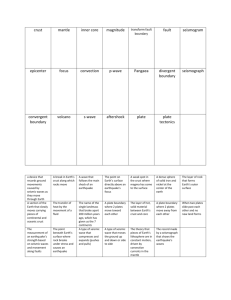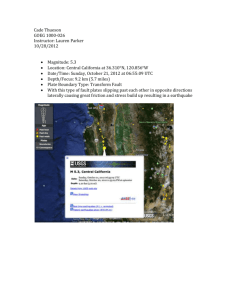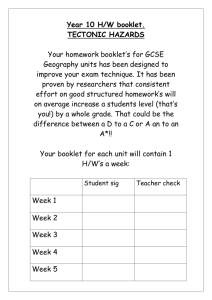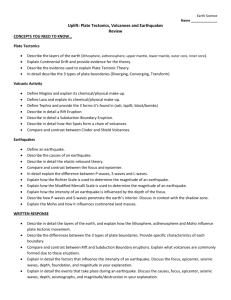geology 3100 natural disasters first exam sp 2006
advertisement
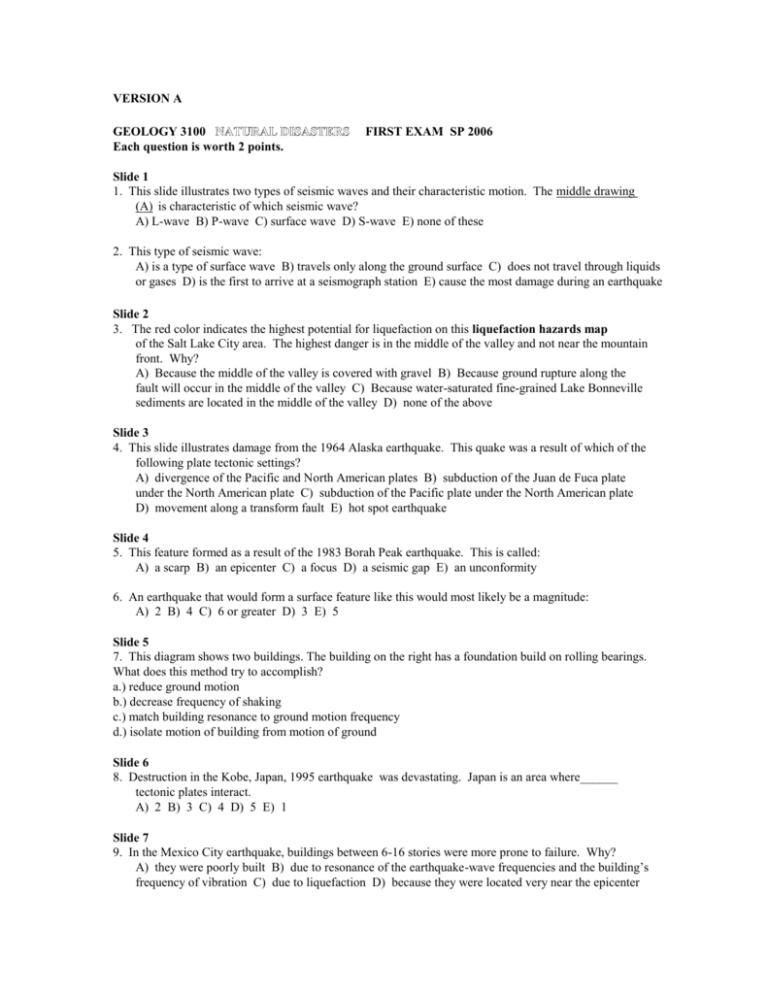
VERSION A GEOLOGY 3100 NATURAL DISASTERS Each question is worth 2 points. FIRST EXAM SP 2006 Slide 1 1. This slide illustrates two types of seismic waves and their characteristic motion. The middle drawing (A) is characteristic of which seismic wave? A) L-wave B) P-wave C) surface wave D) S-wave E) none of these 2. This type of seismic wave: A) is a type of surface wave B) travels only along the ground surface C) does not travel through liquids or gases D) is the first to arrive at a seismograph station E) cause the most damage during an earthquake Slide 2 3. The red color indicates the highest potential for liquefaction on this liquefaction hazards map of the Salt Lake City area. The highest danger is in the middle of the valley and not near the mountain front. Why? A) Because the middle of the valley is covered with gravel B) Because ground rupture along the fault will occur in the middle of the valley C) Because water-saturated fine-grained Lake Bonneville sediments are located in the middle of the valley D) none of the above Slide 3 4. This slide illustrates damage from the 1964 Alaska earthquake. This quake was a result of which of the following plate tectonic settings? A) divergence of the Pacific and North American plates B) subduction of the Juan de Fuca plate under the North American plate C) subduction of the Pacific plate under the North American plate D) movement along a transform fault E) hot spot earthquake Slide 4 5. This feature formed as a result of the 1983 Borah Peak earthquake. This is called: A) a scarp B) an epicenter C) a focus D) a seismic gap E) an unconformity 6. An earthquake that would form a surface feature like this would most likely be a magnitude: A) 2 B) 4 C) 6 or greater D) 3 E) 5 Slide 5 7. This diagram shows two buildings. The building on the right has a foundation build on rolling bearings. What does this method try to accomplish? a.) reduce ground motion b.) decrease frequency of shaking c.) match building resonance to ground motion frequency d.) isolate motion of building from motion of ground Slide 6 8. Destruction in the Kobe, Japan, 1995 earthquake was devastating. Japan is an area where______ tectonic plates interact. A) 2 B) 3 C) 4 D) 5 E) 1 Slide 7 9. In the Mexico City earthquake, buildings between 6-16 stories were more prone to failure. Why? A) they were poorly built B) due to resonance of the earthquake-wave frequencies and the building’s frequency of vibration C) due to liquefaction D) because they were located very near the epicenter MAP – Use the map to answer the following questions. 10. What type of plate boundary is located in the middle of the Atlantic Ocean? A) divergent margin B) transform margin C) passive margin D) active margin E) spreading margin 11. What type of plate boundary exists along the Aleutian Islands of Alaska? A) continent-continent B) transform C) ocean-continent D) divergent E) ocean-ocean 12. There could be deep focus earthquakes along the west coast of South America because it is which of the following types of plate boundary: A) transform B) ocean-continent convergence C) continent-continent convergence D) divergent 13. What type of plate boundary exists in the middle of the Atlantic Ocean? A) ocean-ocean convergence B) ocean-continent convergence C) continent-continent convergence D) divergent 14. What type of plate boundary occurs along the northern margin of India? A) transform B) convergent C) divergent D) there are no plate boundaries along the margins of the continent MULTIPLE CHOICE 15. Which magnitude scale is more precise in measuring the energy release of large earthquakes? A) Richter magnitude B) body wave scale C) surface wave scale D) moment magnitude scale 16. Seismographs operate on the principle of: A) a mass has intertia B) the ground moves only horizontally C) only vertical ground motion can be 17. Tsunami are a result of: A) displacement of the ocean floor along a fault B) large and severe storms C) fires from broken utility lines D) magma moving upward in a magma chamber 18. The federal Emergency Management Agency was established in: A) 1934 B) 1979 C) 1968 D) 1961 E) 1974 19. The point on the surface of earth directly above where the earthquake originates is called the: A) focus B) scarp C) seiche D) epicenter E) liquefaction zone 20. In which geographic location is the risk from an earthquake higher? A) San Francisco B) in the wilds of Alaska C) New Madrid, Missouri D) Salt Lake City 21. The earthquake intensity scale which measures the intensity of a quake in terms of physical damage is called the: A) Macaroni Scale B) Richter Scale C) Modified Mercalli Scale D) Roman Numeral Scale 22 Which of the following are mitigation possibilities for natural disasters: A) land-use planning B) insurance C) financial incentives D) structure design E) all of the above 23. The North American plate is in contact with the Pacific plate along the San Andreas fault in California. What type of plate boundary is this? A) diverging plate boundary B) converging plate boundary C) transform plate boundary D) mantle plume boundary 24. The most important ingredient creating natural disasters is: A) energy B) wind C) water D) plate tectonics E) gravity 25. Which of the following geographic locations will experience only shallow-focus earthquakes? A ) Japan B) Ice Land C) Anchorage, Alaska D) Seattle, Washington 26. Most of Earth’s internal heat is created by: A) radioactive decay B) solar energy C) gravity D) tide energy 27. Magma is generated at convergent boundaries by: A) partial melting of the asthenosphere due to a decrease of pressure (decompression melting) B) subduction of oceanic crust & the presence of water C) intense heat caused from continentcontinent collisions 28. In plate tectonic theory, it is proposed that rigid crustal plates or blocks are capable of motion. That portion of the Earth's interior on which these rigid blocks move, is known as the: A) Moho B) asthenosphere C) shadow zone D) stratosphere E) liquid core 29. The Cascade Mountains of Washington and Oregon represent a: A) spreading center B) transform plate boundary C) hot spot D) continent-continent boundary E) ocean-continent boundary 30. I will be in class in the future because we are going to continue our discussion on natural disasters and they are way interesting! A) of course I'll be here B) wouldn't miss class for anything! C) Yep, I'll be here D) all of the above 31. Evidence favoring plate tectonics includes all the following except: A) patterns of magnetic reversals of rocks as determined by paleomagnetism B) distribution of areas subjected to past glaciations C) distribution of similar plant and animal fossils in the various continents D) similar mountain ranges and geologic structures on the various continents E) the ocean floors consist of sedimentary rocks which are 4.5 billion years old. 32. The amount of destruction caused by earthquake vibrations is affected by: A) the design of structures B) the intensity and duration of the vibrations C) the nature of the surface material D) all of the above 33. Which of the following is the accurate model for the Wasatch Fault? A) magnitude 5-5.5, occurs in 25 mile segments, expects 2-5 feet of displacement B) magnitude 77.5, occurs in 25 mile segments, expects 6-15 feet of displacement C) magnitude 5.5-6.5, occurs in 100 mile segments, expects 3-6 feet of displacement 34. Oceanic crust always subducts under continental crust because: A) it is more dense B) is is less dense C) it is thicker D) it is 35. What do geologists in Utah most commonly do to learn about past earthquakes? A) they use tree rings to look for patterns B) they dig trenches to determine earthquake history C) they put in strain meters to measure force in the rocks D) all of the above 36. The Seattle earthquake was a result of which of the following? A) subduction zone tectonics B) escape tectonics C) tension from divergence D) hot spot activity E) transform tectonics 38. How far was Mexico City from the epicenter of the earthquake that caused so much damage to the city? A) 100 miles B) 50 miles C) 450 miles D) 300 miles E) 250 miles 39. The Loma Prieta earthquake was an example of which of the following plate tectonic settings: A) divergent boundary B) hot spot C) convergent boundary D) transform boundary 40. The segment of the Wasatch Fault that has not ruptured in the past few thousand years and therefore the most likely to rupture in the future is: A) the Ogden segment B) the Cache Valley segment C) the Brigham City segment D) the Nephi segment E) the Salt Lake City segment 41. Which of the following seismic waves do not pass through a liquid? A) P-waves B) Rayleigh-waves C) S-waves D) water waves E) waves of oscillation 42. Which type of stress causes the largest magnitude earthquakes? A) shear B) compression C) tension 43. An earthquake warning system is being developed in Japan and the US. It is based on the: A) amount of strain in the rocks B) how animals react C) detail information on arrival of P waves D) the amount of ground rupture from the arrival of S waves 44. The tremendous loss of life in the Indonesia earthquake resulted from: A) no tsunami warning system in place B) lack of seismograph information C) poor building construction D) different types of rocks 45. Considering its distance from the source of the September 19, 1985 earthquake, Mexico City was damaged more than might be expected because: A) the buildings were very poorly designed B) the buildings were very close together C) the city was built on granite which readily transmitted the vibrations D) the unconsolidated sediments on which the city was built intensifiedthe vibrations E) the buildings were excessively tall 46. In a high magnitude earthquake, which seismic waves cause the most ground motion? A) S-wave B) P-wave C) L-wave 47. In which area would an earthquake be least likely to occur: A) California B) South Dakota C) Utah D) Southern China E) Philippines 48. An intensity ground shaking map, created instantly after and earthquake, is useful for: A) land use planners B) emergency management personnel C) homebuyers 49. You have recently moved to Cache Valley and are terrified of the prospect of an earthquake. Which of the following would be the safest place to live? A) a basement apartment located within 400 feet of the fault B) a multiple story cement block structure located several miles from the fault zone in the middle of the valley C) a single story 50. In order to determine the distance from a seismometer to an earthquake, you must measure A) the speed of the surface waves. B) the ratio of the amplitude of the largest P and S waves. C) the arrival times of the surface waves. D) the difference in arrival times of the P and S waves. E) something other than the choices given above. THE END


